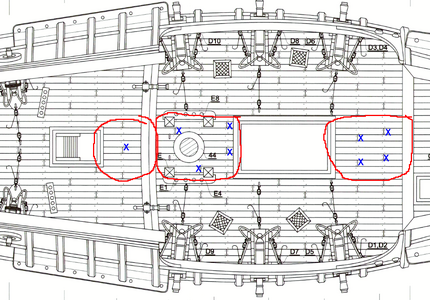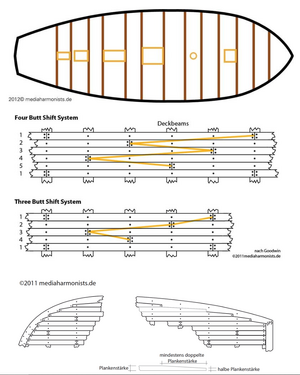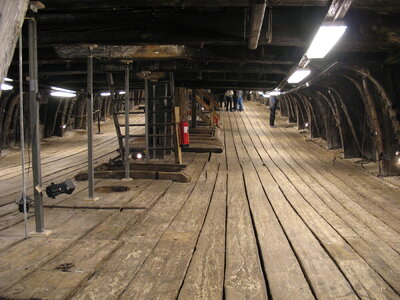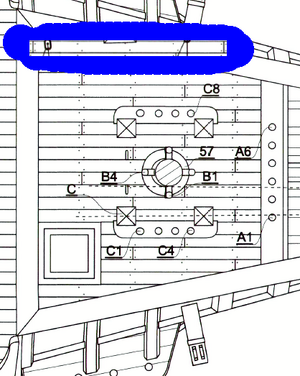-

Win a Free Custom Engraved Brass Coin!!!
As a way to introduce our brass coins to the community, we will raffle off a free coin during the month of August. Follow link ABOVE for instructions for entering.
You are using an out of date browser. It may not display this or other websites correctly.
You should upgrade or use an alternative browser.
You should upgrade or use an alternative browser.
very good explanation by Kurt
Definitely important is, that the treenails and the butt joints are over the deck beams (of the real ship) and not the bulkheads
Definitely important is, that the treenails and the butt joints are over the deck beams (of the real ship) and not the bulkheads
and in addition the real shipwrights used the timber board, which were available
so often the boards had different lengths - and than they had to adjust the patterns
so often the boards had different lengths - and than they had to adjust the patterns
I agree with all the above, of course, but have wondered on occasion when an area to be planked is no longer than a single plank. I will use my Ragusian Carrack as an example:

The plans show the areas circled in red continuing the planking pattern, even though they are short enough to have been planked without joints. That is, the joints I've X'd in blue need not be there, I think. I've included them in my model, as the continuous pattern looks good, but in reality, wouldn't they have been left a single plank for these areas, rather than being cut unnecessarily, creating weaker areas and more joints to caulk?
Hmmm - I've rethought this a bit. The 2nd circled area (left to right) definitely continues to the left, so this would not apply. And the planking circled to the right probably continue on the other side of the forecastle exterior bulkhead, so this may not apply. The leftmost circled example, however, definitely WOULD apply to this question.
Also, When the decking pattern and deck beams below would end up resulting in an extremely short plank, like the rightmost two X's in the middle circled areas, one wonders if a slightly modified pattern resulting in longer end beams might make more sense.
I guess the question is: would the attractiveness and consistency of a pattern take precedence over the entire deck, or would more practical modifications to this pattern be made?

The plans show the areas circled in red continuing the planking pattern, even though they are short enough to have been planked without joints. That is, the joints I've X'd in blue need not be there, I think. I've included them in my model, as the continuous pattern looks good, but in reality, wouldn't they have been left a single plank for these areas, rather than being cut unnecessarily, creating weaker areas and more joints to caulk?
Hmmm - I've rethought this a bit. The 2nd circled area (left to right) definitely continues to the left, so this would not apply. And the planking circled to the right probably continue on the other side of the forecastle exterior bulkhead, so this may not apply. The leftmost circled example, however, definitely WOULD apply to this question.
Also, When the decking pattern and deck beams below would end up resulting in an extremely short plank, like the rightmost two X's in the middle circled areas, one wonders if a slightly modified pattern resulting in longer end beams might make more sense.
I guess the question is: would the attractiveness and consistency of a pattern take precedence over the entire deck, or would more practical modifications to this pattern be made?
I think logic would trump the deck pattern and all of the ones you marked, plus two more to the left of the stairs would not be there. The guy that did the drawing probably just blindly put in the butt joints wherever his pattern said.
I agree, although an interrupted or changed pattern does seem to stand out visually and just "look" wrong.I think logic would trump the deck pattern and all of the ones you marked, plus two more to the left of the stairs would not be there. The guy that did the drawing probably just blindly put in the butt joints wherever his pattern said.
I've found a few things about these ships that seems wrong. Whether or not they were actually like that is lost to time.
- Joined
- Feb 15, 2019
- Messages
- 377
- Points
- 168

I would put a single short plank in. If you don't mark (over mark!) the joints and nails but keep the marking subtle no disruption of pattern is evident. It's a common mistake to make the joins and fixings too dark.I agree with all the above, of course, but have wondered on occasion when an area to be planked is no longer than a single plank. I will use my Ragusian Carrack as an example:
View attachment 435311
The plans show the areas circled in red continuing the planking pattern, even though they are short enough to have been planked without joints. That is, the joints I've X'd in blue need not be there, I think. I've included them in my model, as the continuous pattern looks good, but in reality, wouldn't they have been left a single plank for these areas, rather than being cut unnecessarily, creating weaker areas and more joints to caulk?
Hmmm - I've rethought this a bit. The 2nd circled area (left to right) definitely continues to the left, so this would not apply. And the planking circled to the right probably continue on the other side of the forecastle exterior bulkhead, so this may not apply. The leftmost circled example, however, definitely WOULD apply to this question.
Also, When the decking pattern and deck beams below would end up resulting in an extremely short plank, like the rightmost two X's in the middle circled areas, one wonders if a slightly modified pattern resulting in longer end beams might make more sense.
I guess the question is: would the attractiveness and consistency of a pattern take precedence over the entire deck, or would more practical modifications to this pattern be made?
As for a pattern, I usually do a 4 butt. However having looked down at Victory's deck from the quarterdeck I can't work out any pattern at all, they don't seem to be reciprocal either side of the king plank. Unfortunately I can't find the photos I took.
In the example shown by @Signet no butt joints would be there - only complete planks over the complete length
also at the forecastle deck - only planks without butts
every pattern of butt joints would be technically wrong
remeber: every joint is weakening the structure, so the shipwrights would not add, the there are wooden boards available which are long enough
also at the forecastle deck - only planks without butts
every pattern of butt joints would be technically wrong
remeber: every joint is weakening the structure, so the shipwrights would not add, the there are wooden boards available which are long enough







